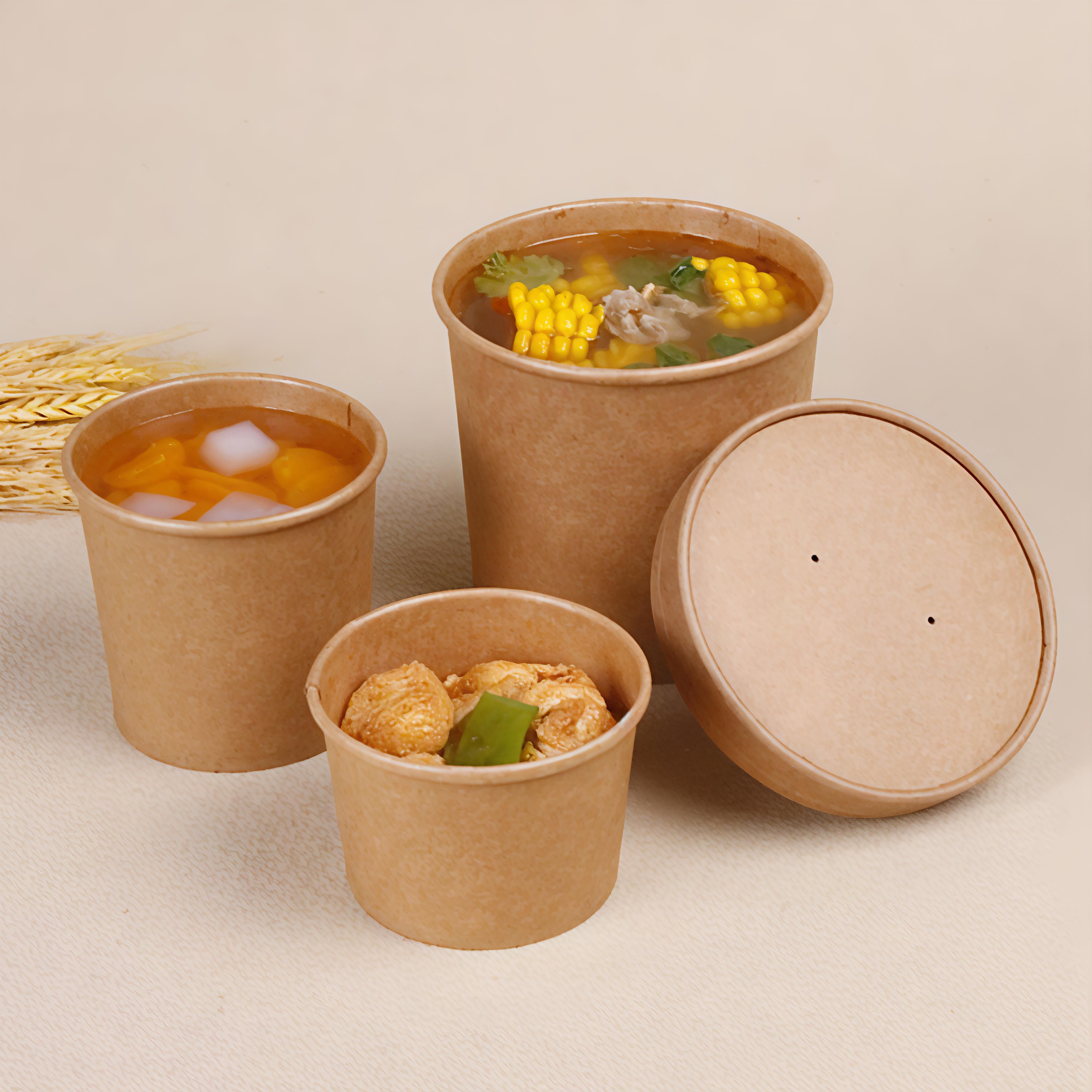Key Performance Requirements for Paper Bowls Used with Soup
Heat Resistance: Maintaining Integrity at High Temperatures
Good quality paper bowls need to hold up against hot soups for quite some time without bending out of shape or falling apart. The better ones stay firm even when they reach around 120 degrees Celsius, especially if they have a lining made from either polyethylene or polylactic acid. Going for double walls makes a big difference too. These designs cut down on how much heat gets transferred to fingers by about forty percent compared to regular single wall bowls. Plus, food stays warmer longer - somewhere between thirty to fifty percent longer actually. That's why restaurants and takeout places often prefer them for deliveries and keeping meals warm during long waits.
Moisture and Leak Resistance: Preventing Breakdown from Liquid Exposure
Effective liquid barriers are essential, as soups contain 85–95% water. Advanced coatings like PLA create watertight seals that prevent leaks for up to 4 hours critical for food delivery. Precision extrusion processes apply 18–22 micron coating layers, optimizing material use while ensuring reliable leak protection.
Structural Strength: Avoiding Sogginess and Collapse During Use
Paperboard bowls in the 250 to 350 GSM range hold up well against getting soggy and keep their shape when something is placed on top. When we look at cupstock materials specifically, they manage to stay rigid for quite some time. After sitting in liquid for about half an hour, these materials still have around 92% of their original stiffness. That's way better than regular kraft paper which drops down to just 67% rigidity under similar conditions. What really helps boost strength are those design features manufacturers include. Rolled edges and fluted bottoms can actually make a bowl about 30% stronger overall. This means the bowl won't cave in even when holding heavier items like thick soups weighing more than half a kilogram.
Common Types of Paper Bowls for Soup: Materials and Design Differences
When selecting paper bowls for soup, material choices and structural designs directly impact performance and cost efficiency. Below, we break down three critical considerations for foodservice operators.
Single Wall vs. Double Wall Construction: Balancing Insulation and Cost
| Feature | Single-Wall Bowls | Double-Wall Bowls |
|---|---|---|
| Insulation | Limited heat retention (30–45 mins) | Superior thermal barrier (60+ mins) |
| Cost | 25–30% cheaper | Higher material and production costs |
| Use Case | Short-term serving, budget-conscious ops | Extended service periods (catering, delivery) |
Single-wall bowls use one layer of paperboard with a thin liner, offering lightweight convenience but limited insulation. Double-wall options incorporate an air gap between layers, reducing hand heat by 50% compared to single-wall designs, enhancing user comfort during transport and service.
Kraft Paper and Bagasse Bowls: Durability and Sustainability Compared
Kraft paper bowls come from unbleached wood pulp and can hold up against grease pretty well. They generally stay intact when holding hot liquids for around two hours before starting to break down. Then there's bagasse bowls made from sugarcane waste. These decompose much quicker than regular paper products in industrial compost settings about 60 days compared to the standard 90 day mark for most papers. The reason? Their fibers are packed tighter together which makes them handle oily soups better without getting soggy. While both options will eventually turn back into soil, bagasse tends to perform better overall especially when dealing with wetter foods or longer exposure times. Restaurants serving things like chili or tomato based sauces often find this difference quite noticeable in practice.
Cupstock and PLA Coated Bowls: Advanced Materials for Liquid Retention
Bowl made from cupstock stock and coated with polyethylene (PE) can hold back leaks for around four to six hours, though they create problems when it comes time to recycle because of all the different materials mixed together. There are now alternatives with PLA coatings instead. Polylactic acid is basically what makes up these coatings, and it comes from plants rather than petroleum products. These bowls seem to resist leaking just as well as their PE counterparts, plus they break down in industrial composting facilities. When put through stress tests, bowls lined with PLA kept their shape even when filled with hot liquids at about 90 degrees Celsius for nearly an hour and a half without warping or changing form. That kind of durability means they work pretty well for serving soups and other similar foods under normal restaurant conditions.
Coating Technologies in Paper Bowls: Plastic vs. PLA Linings
Leak Resistance and Coating Performance in Hot Soup Applications
To keep contents from leaking out, paper bowls need special coatings that hold up when exposed to heat, typically around 95 degrees Celsius or so. The most common solution is polyethylene lining which acts as a good moisture barrier. Research indicates these PE coated bowls can handle hot drinks about 30 percent longer compared to ones without any coating. On the flip side, PLA coatings made from plant based materials start breaking down once they hit around 85 degrees Celsius, making them unsuitable for things like boiling broth or soup. Most manufacturers aim for a coating thickness between 20 and 30 microns because this range seems to work best without wasting too much material. But going beyond that recommended range adds extra plastic to the product, increasing the overall plastic content by roughly 15 to 20 percent, something many eco conscious consumers might want to avoid.
Chemical Safety and Food Contact Compliance of Coated Paper Bowls
PE and PLA coatings need to meet those strict FDA and EU standards for touching food stuffs, basically so nothing bad leaches into what we eat. Now, PE stays pretty stable when temps stay under 100 degrees Celsius, but some recent lab work found tiny amounts of volatile stuff coming off PE lined bowls after they sat in boiling water for half an hour or more. On the flip side, PLA is made from plants which means no nasty petrochemicals involved. But here's the catch: these materials only break down properly in industrial composting facilities. And guess what? Most places don't even have access to this kind of system. Recent waste reports show around three quarters of U.S. cities still lack proper industrial composting options as of 2024.
Recyclability Challenges of Plastic Coated Paper Bowls
Less than 10 percent of those plastic lined paper bowls actually get recycled because nobody wants to deal with peeling apart the plastic from the paper layer. According to some research on circular economies, regular plastic coated bowls can take anywhere from 18 to 24 months just to start breaking down in landfills. The plant based PLA coated ones? Those will rot away in about 3 to 6 months if they end up in proper compost facilities. But here's the catch: only around 12% of people even have access to those industrial composting centers. So there's this big disconnect happening where products look green on paper but aren't really working out so well when it comes time to throw them away.
Environmental Impact: Compostability and Sustainability of Paper Soup Bowls
Biodegradability Conditions for PLA Coated and Bagasse Paper Bowls
For PLA coatings to break down properly, they need special industrial composting setups with temperatures between roughly 50 and 60 degrees Celsius plus active microbes over about three months. Bagasse bowls take closer to half a year to decompose when composted normally because of how fibrous and full of holes they are. Things get really tricky in regular landfills though since there's so little oxygen present. When buried like this, both materials basically stop breaking down completely or take forever, maybe even 90% slower than normal. Studies indicate that nearly two thirds of all PLA coated bowls actually wind up getting thrown away incorrectly somewhere along the line, which kind of defeats the whole point of going green with these products in the first place.
Understanding Labels: Recyclable, Biodegradable, or Truly Compostable?
BPI (Biodegradable Products Institute) and TUV OK Compost certifications actually tell us whether something will truly compost or not, which helps separate genuine eco-friendly products from items just slapped with the word biodegradable on their packaging. Take those common soup bowls made with PLA or water-based coatings for instance they simply won't go into regular recycling bins and end up messing up entire batches of paper being recycled. Watch out for companies trying to pull the wool over our eyes with vague biodegradable labels. Some of these products contain petroleum based ingredients that don't really disappear but instead turn into tiny plastic particles we call microplastics, which is definitely not what most people think when they hear the term compostable.
Reducing Plastic Waste with Sustainable Paper Bowl Alternatives
When businesses switch over to those certified compostable paper bowls instead of their plastic lined counterparts, they typically see a drop in carbon emissions somewhere between 30 to 50 percent. Facilities that have made the move to materials like bagasse or FSC certified paper products are seeing something pretty remarkable too around 80% less stuff going out as non recyclable waste each year. To get the most out of this change though, it really helps to match those bowls with lids made from cellulose material. And here's another thing worth mentioning: many people don't realize how important proper disposal actually is. When compostables end up mixed with regular trash, almost 40% of them become completely useless during waste audits because they're contaminated. That means all that effort goes down the drain literally.
FAQ Section
What is the ideal temperature for paper bowls to hold hot soup without losing integrity?
Paper bowls with high-quality lining can maintain their shape and integrity at temperatures up to 120 degrees Celsius.
How long can paper bowls with advanced coatings resist leaks?
Pla-coated paper bowls can resist leaks for up to 4 hours, making them suitable for food delivery services.
Are PLA-coated bowls truly compostable?
PLA-coated bowls are compostable, but they require industrial composting conditions, which many areas lack.
Do paper bowls contribute to plastic waste?
Traditional paper bowls with plastic linings contribute to plastic waste due to challenges in separating materials for recycling, whereas certified compostable bowls reduce emissions and waste.



